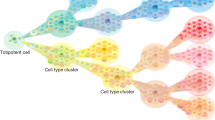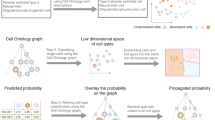Abstract
Massive single-cell profiling efforts have accelerated our discovery of the cellular composition of the human body while at the same time raising the need to formalize this new knowledge. Here, we discuss current efforts to harmonize and integrate different sources of annotations of cell types and states into a reference cell ontology. We illustrate with examples how a unified ontology can consolidate and advance our understanding of cell types across scientific communities and biological domains.
This is a preview of subscription content, access via your institution
Access options
Access Nature and 54 other Nature Portfolio journals
Get Nature+, our best-value online-access subscription
$32.99 / 30 days
cancel any time
Subscribe to this journal
Receive 12 print issues and online access
$209.00 per year
only $17.42 per issue
Buy this article
- Purchase on SpringerLink
- Instant access to full article PDF
Prices may be subject to local taxes which are calculated during checkout


Similar content being viewed by others
References
Regev, A. et al. The Human Cell Atlas. eLife 6, e27041 (2017).
Rozenblatt-Rosen, O., Stubbington, M. J. T., Regev, A. & Teichmann, S. A. The Human Cell Atlas: from vision to reality. Nature 550, 451–453 (2017).
Aldridge, S. & Teichmann, S. A. Single cell transcriptomics comes of age. Nat. Commun. 11, 4307 (2020).
Popescu, D. M. et al. Decoding human fetal liver haematopoiesis. Nature 574, 365–371 (2019).
Madissoon, E. et al. scRNA-seq assessment of the human lung, spleen, and esophagus tissue stability after cold preservation. Genome Biol. 21, 1 (2019).
Hagai, T. et al. Gene expression variability across cells and species shapes innate immunity. Nature 563, 197–202 (2018).
Vento-Tormo, R. et al. Single-cell reconstruction of the early maternal–fetal interface in humans. Nature 563, 347–353 (2018).
Hodge, R. D. et al. Conserved cell types with divergent features in human versus mouse cortex. Nature 573, 61–68 (2019).
Drokhlyansky, E. et al. The human and mouse enteric nervous system at single-cell resolution. Cell 182, 1606–1622.e23 (2020).
Elmentaite, R. et al. Cells of the human intestinal tract mapped across space and time. Nature 597, 250–255 (2021).
Bodenreider, O. & Stevens, R. Bio-ontologies: current trends and future directions. Brief. Bioinform 7, 256–274 (2006).
Diehl, A. D. et al. The Cell Ontology 2016: enhanced content, modularization, and ontology interoperability. J. Biomed. Semant. 7, 44 (2016).
Costa, M., Reeve, S., Grumbling, G. & Osumi-Sutherland, D. The Drosophila anatomy ontology. J. Biomed. Semant. 4, 32 (2013).
Consortium, E. P. An integrated encyclopedia of DNA elements in the human genome. Nature 489, 57–74 (2012).
Smith, B. et al. The OBO Foundry: coordinated evolution of ontologies to support biomedical data integration. Nat. Biotechnol. 25, 1251–1255 (2007).
Milyaev, N. et al. The Virtual Fly Brain browser and query interface. Bioinformatics 28, 411–415 (2012).
Osumi-Sutherland, D., Costa, M., Court, R. & O’Kane, C. J. Virtual Fly Brain—using OWL to support the mapping and genetic dissection of the Drosophila brain. CEUR Workshop Proc. 1265, 85–96 (2014).
Li, H. et al. Fly Cell Atlas: a single-cell transcriptomic atlas of the adult fruit fly. Preprint at bioRxiv https://doi.org/10.1101/2021.07.04.451050 (2021).
Gene Ontology, C. The Gene Ontology resource: enriching a GOld mine. Nucleic Acids Res. 49, D325–D334 (2021).
Mungall, C. J. et al. The Monarch Initiative: an integrative data and analytic platform connecting phenotypes to genotypes across species. Nucleic Acids Res. 45, D712–D722 (2017).
Jacqz, E., Branch, R. A., Heidemann, H. & Aujard, Y. [Prevention of nephrotoxicity of amphotericin B during the treatment of deep candidiasis]. Ann. Biol. Clin. (Paris) 45, 689–693 (1987).
Hu, B. C. The human body at cellular resolution: the NIH Human Biomolecular Atlas Program. Nature 574, 187–192 (2019).
Ecker, J. R. et al. The BRAIN Initiative Cell Census Consortium: lessons learned toward generating a comprehensive brain cell atlas. Neuron 96, 542–557 (2017).
Young, M. D. et al. Single-cell transcriptomes from human kidneys reveal the cellular identity of renal tumors. Science 361, 594–599 (2018).
Sungnak, W. et al. SARS-CoV-2 entry factors are highly expressed in nasal epithelial cells together with innate immune genes. Nat. Med. 26, 681–687 (2020).
Muus, C. et al. Single-cell meta-analysis of SARS-CoV-2 entry genes across tissues and demographics. Nat. Med. 27, 546–559 (2021).
Delorey, T. M. et al. COVID-19 tissue atlases reveal SARS-CoV-2 pathology and cellular targets. Nature 595, 107–113 (2021).
Mungall, C. J., Torniai, C., Gkoutos, G. V., Lewis, S. E. & Haendel, M. A. Uberon, an integrative multi-species anatomy ontology. Genome Biol. 13, R5 (2012).
Bernard, A., Boumsell, L., Daussett, J., Milstein, C. & Schlossman, S. F. (eds) Leucocyte Typing: Human Leucocyte Differentiation Antigens Detected by Monoclonal Antibodies: Specification, Classification, Nomenclature = Typage Leucocytaire: Antigènes de Différenciation Leococytaire Humains Révélés par les Anticorps Monoclonaux (Springer, 1984).
Reinherz, E. L., Haynes, B. F., Nadler, L. M. & Bernstein, I. D. (eds) Leukocyte Typing II (Springer, 1986).
McMichael, A. J. (ed.) Leucocyte Typing III: White Cell Differentiation Antigens (Oxford Univ. Press, 1987).
Knapp, W. et al. (eds) Leucocyte Typing IV: White Cell Differentiation Antigens (Oxford Univ. Press, 1989).
Schlossman, S. F. (ed.) Leucocyte typing V: white cell differentiation antigens. In Proc. Fifth International Workshop and Conference held in Boston, USA, 3–7 November, 1993 (Oxford Univ. Press, 1995).
Kishimoto, T. (ed.) Leucocyte typing VI: white cell differentiation antigens. In Proc. Sixth International Workshop and Conference held in Kobe, Japan, 10–14 November 1996 (Garland, 1998).
Mason, D. (ed.) Leucocyte typing VII: white cell differentiation antigens. In Proc. Seventh International Workshop and Conference held in Harrogate, United Kingdom (Oxford University Press: Oxford, 2002).
Zola, H., Swart, B., Nicholson, I. & Voss, E. Leukocyte and Stromal Cell Molecules: The CD Markers (Wiley-Liss, 2007).
Yuste, R. et al. A community-based transcriptomics classification and nomenclature of neocortical cell types. Nat. Neurosci. 23, 1456–1468 (2020).
Shekhar, K. et al. Comprehensive classification of retinal bipolar neurons by single-cell transcriptomics. Cell 166, 1308–1323.e30 (2016).
Vermeiren, S., Bellefroid, E. J. & Desiderio, S. Vertebrate sensory ganglia: common and divergent features of the transcriptional programs generating their functional specialization. Front. Cell Dev. Biol. 8, 587699 (2020).
Driskell, R. R. & Watt, F. M. Understanding fibroblast heterogeneity in the skin. Trends Cell Biol. 25, 92–99 (2015).
Miao, Z. et al. Putative cell type discovery from single-cell gene expression data. Nat. Methods 17, 621–628 (2020).
Bakken, T. E. et al. Comparative cellular analysis of motor cortex in human, marmoset and mouse. Nature 598, 111–119 (2021).
Miller, J. A. et al. Common cell type nomenclature for the mammalian brain. eLife 9, e59928 (2020).
Börner, K. et al. Anatomical structures, cell types and biomarkers of the Human Reference Atlas. Nat. Cell Biol. https://doi.org/10.1038/s41556-021-00788-6 (2021).
Qi, Z. et al. Single-cell deconvolution of head and neck squamous cell carcinoma. Cancers (Basel) 13, 2387 (2021).
Kiselev, V. Y., Yiu, A. & Hemberg, M. scmap: projection of single-cell RNA-seq data across data sets. Nat. Methods 15, 359–362 (2018).
Kimmel, J. C. & Kelley, D. R. Semi-supervised adversarial neural networks for single-cell classification. Genome Res. 31, 1781–1793 (2021).
Domínguez, C.C. et al. Cross-tissue immune cell analysis reveals tissue-specific adaptations and clonal architecture across the human body. Preprint at bioRxiv https://doi.org/10.1101/2021.04.28.441762 (2021).
Hao, Y. et al. Integrated analysis of multimodal single-cell data. Cell 184, 3573–3587.e29 (2021).
Aran, D. et al. Reference-based analysis of lung single-cell sequencing reveals a transitional profibrotic macrophage. Nat. Immunol. 20, 163–172 (2019).
Bernstein, M. N., Ma, Z., Gleicher, M. & Dewey, C. N. CellO: comprehensive and hierarchical cell type classification of human cells with the Cell Ontology. iScience 24, 101913 (2021).
Hou, R., Denisenko, E. & Forrest, A. R. R. scMatch: a single-cell gene expression profile annotation tool using reference datasets. Bioinformatics 35, 4688–4695 (2019).
Orvis, J. et al. gEAR: gene expression analysis resource portal for community-driven, multi-omic data exploration. Nat. Methods 18, 843–844 (2021).
Megill, C. et al. cellxgene: a performant, scalable exploration platform for high dimensional sparse matrices. Preprint at bioRxiv https://doi.org/10.1101/2021.04.05.438318 (2021).
Stewart, B. J. et al. Spatiotemporal immune zonation of the human kidney. Science 365, 1461–1466 (2019).
James, K. R. et al. Distinct microbial and immune niches of the human colon. Nat. Immunol. 21, 343–353 (2020).
Vieira Braga, F. A. et al. A cellular census of human lungs identifies novel cell states in health and in asthma. Nat. Med. 25, 1153–1163 (2019).
Travaglini, K. J. et al. A molecular cell atlas of the human lung from single-cell RNA sequencing. Nature 587, 619–625 (2020).
Ramachandran, P. et al. Resolving the fibrotic niche of human liver cirrhosis at single-cell level. Nature 575, 512–518 (2019).
Aizarani, N. et al. A human liver cell atlas reveals heterogeneity and epithelial progenitors. Nature 572, 199–204 (2019).
Litvinukova, M. et al. Cells of the adult human heart. Nature 588, 466–472 (2020).
Park, J. E. et al. A cell atlas of human thymic development defines T cell repertoire formation. Science 367, eaay3224 (2020).
Reynolds, G. et al. Developmental cell programs are co-opted in inflammatory skin disease. Science 371, eaba6500 (2021).
Garcia-Alonso, L. et al. Mapping the temporal and spatial dynamics of the human endometrium in vivo and in vitro. Nat. Genetics https://doi.org/10.1038/s41588-021-00972-2 (2021).
Acknowledgements
We are grateful to J. Eliasova (scientific illustrator) for support with the figure, to R. Vento-Tormo for comments on the figure and texts, and to the following clinicians and researchers for information on standard pathology markers for tissues and cells: L. Campos, A. Dean, L. Moore, N. Sebire, T. Brevini, M. Haniffa, J. E. Kwa, J. McCaffrey and A. Kreins. We also thank all members of the CL and Uberon editorial teams, including C. Mungall, N. Matentzoglu, A. Diehl, N. Washington, S. Tan, P. Roncaglia, T. Lubiana and D. Goutte-Gattat. Research reported in this publication was supported by the Wellcome Trust (grant 108413/A/15/D), the Office of the Director, National Institutes of Health of the National Institutes of Health (under award number OT2OD026682’), grants from the CZI (Chan Zuckerberg Initiative DAF, an advised fund of Silicon Valley Community Foundation), and Schmidt Futures (Grant 74). This publication is part of the HCA (www.humancellatlas.org/publications/).
Author information
Authors and Affiliations
Corresponding author
Ethics declarations
Competing interests
Since January 2019, S.A.T. has been remunerated for consulting and SAB membership by Foresite Labs, GlaxoSmithKline, Biogen, Roche and Genentech, and is a founder and equity holder of Transition Bio. A.R. is a cofounder and equity holder in Celsius Therapeutics, an equity holder in Immunitas Therapeutics, and was a scientific advisory board member for ThermoFisher Scientific, Asimov, Syros Pharmaceuticals and Neogene Therapeutics until 31 July 2020. From 1 August 2020, A.R. is an employee of Genentech, a member of the Roche group. A.R. is a named inventor on several patents and patent applications filed by the Broad Institute in the area of single-cell and spatial genomics. The other authors declare no competing interests.
Additional information
Publisher’s note Springer Nature remains neutral with regard to jurisdictional claims in published maps and institutional affiliations.
Rights and permissions
About this article
Cite this article
Osumi-Sutherland, D., Xu, C., Keays, M. et al. Cell type ontologies of the Human Cell Atlas. Nat Cell Biol 23, 1129–1135 (2021). https://doi.org/10.1038/s41556-021-00787-7
Received:
Accepted:
Published:
Issue Date:
DOI: https://doi.org/10.1038/s41556-021-00787-7
This article is cited by
-
Single-cell data combined with phenotypes improves variant interpretation
BMC Genomics (2025)
-
Unified high-resolution immune cell fraction estimation in blood tissue from birth to old age
Genome Medicine (2025)
-
Considerations for building and using integrated single-cell atlases
Nature Methods (2025)
-
Functional tissue units in the Human Reference Atlas
Nature Communications (2025)
-
simona: a comprehensive R package for semantic similarity analysis on bio-ontologies
BMC Genomics (2024)



